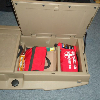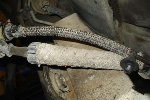- Joined
- January 26, 2004
- Messages
- 6,113
- Reaction score
- 22
- City, State
- Mechanicsville, Virginia
- Year, Model & Trim Level
- 2004 Acura TL
With winter weather somewhat over and ice/snow not much of a factor anymore - I thought I'd share some things for the common 4x4 "light use" enthusiast. Much of the service shops see at winter time is of coarse the four-wheel drive system. Many people have conerning questions about driveline noises or vibrations, especially on semi-iced roads. The popping and jerking while turning was of great concern. Some had difficulty disengaging the 4wd once the ice melted. A lot of repairs resulted from the vehicle finally receiving an inspection. Here are some of the greatest complaints.
The system that generates the majority of complaints is the part-time four-wheel drive system. The system ha scertain operational characteristics that can result in the inexperienced operator assuming that there is a problem within the system. On a part-time system, the transfer case splits the power to the front and rear axles. The transfer case allows the operator to select from rangers 2W/Hi, 4W/Hi, and 4W/Low. It is common for the gears to grind when shifting from neutral into one of the range selections. On this system, the front and rear propeller shafts turn at the same speed with no internal means of matching the tires' rotational rates from front to rear. The result can be driveline loading and increased noise conditions.
NORMAL OPERATIONAL CHARACTERISTICS
1) It is normal for the T-case to emit a noise when being locked into 4x4 engagement.
2) This system is designed for use on a low traction surface such as snow, ice, mud, dirt, etc. These types of surfaces allow for wheel slippage, preventing transfer case and driveline loading and binding (i.e. driving on dry pavement).
3) With 4x4 engagement, a popping and binding sensation should be considered normal when turning. During a turn, the front and rear axles follow a different arc. The compensate the tires must slip. The symptoms are referred to as a crow-hop or grabbing sensation. The same symptoms can occur when the tire circumference varies from front to rear. This is why it is imperative that the tires be rotated on a scheduled basis. Unequal tire pressure from front to rear can promote rotational variations.
4) The noise generated during 4x4 engagement should be considered a normal occurance, as more parts are turning. The noise level is greater when the vehicle is operated on a dry surface as opposed to a low traction surface and the noise level will be greater when driving in 4W/Low.
T-CASE DISENGAGEMENT
On a 4x4 system, especially those equipped with eletric shift (like 2nd-3rd Gens), the system may not disengage when the vehicle has been driven on a dry surface. The variation in the rates of tire rotation results in transfer case loading and binding. When this occurs, the pressure is too great for the electric shift motor to overcome. To confirm, place the vehicle on a lift, allowing the wheels to rotate freely. This relieves the pressure on the transfer case. If the transfer case will now shift properly, it confirms transfer case loading. The first check should involved a tire circumfrence measurement from front to rear. Often we encounter this condition folllowing the installation of the spare tire
TIRE CHECKS
1) Compare tire sizes from front to rear
2) Are all tires the same brand? Tire sizes vary from one tire manufacturer to another. (i.e. BFG 33" M/Ts = 32.6", Interco 33" SSR = 33.4")
3) Pressure check. A low tire has a different rotational rate than an inflated tire.
4) Measure the tread depth of all four tires, as they must be nearly equal.
5) Do not mix tread types, as rotational rates may vary.
AWD POWER TRANSFER UNIT FAILURE
Normally we associate an All Wheel Drive (AWD) system as one that is inteded for use in inclement weather and will operate smoothly on dry pavement. The system is usually designed to allow for a difference in front-to-rear axle rotations. Chrysler acknowledges an extremely high failure rate of their Power Transfer Units (PTU) used in 96-2001 AWD Town & Country, Caravan and Voyager vehicles. Chrysler said it was a design flaw, but later determined that the failures were due to lack of poper tire rotation. Failure to rotate the tires results in uneven front-to-rear tire wear. The variation in the tire circumference from front to rear results in an extreme heat build-up in the PTU. The condition occurs as a result of the continuous variation in rotational speeds and torque transfer between the front and rear drive components. A tire circumference variation as minimal as 0.5% can overhead the PTU. Chrysler recommends a tire rotation at 7,500 miles or less. Watch the air pressure from front to rear, as it can promote the same. When a tire replacement is necessary, chrysler recommends replacing all four tires with a matched set from the same manufacturer. At a cost of $1,200 for a PTU, a little tire maitenance makes good sense.
This isn't really a huge thing on how to fix things, but it's a way to keep from future problems and to possibly diagnois 4x4 problems yourself.
-Drew
The system that generates the majority of complaints is the part-time four-wheel drive system. The system ha scertain operational characteristics that can result in the inexperienced operator assuming that there is a problem within the system. On a part-time system, the transfer case splits the power to the front and rear axles. The transfer case allows the operator to select from rangers 2W/Hi, 4W/Hi, and 4W/Low. It is common for the gears to grind when shifting from neutral into one of the range selections. On this system, the front and rear propeller shafts turn at the same speed with no internal means of matching the tires' rotational rates from front to rear. The result can be driveline loading and increased noise conditions.
NORMAL OPERATIONAL CHARACTERISTICS
1) It is normal for the T-case to emit a noise when being locked into 4x4 engagement.
2) This system is designed for use on a low traction surface such as snow, ice, mud, dirt, etc. These types of surfaces allow for wheel slippage, preventing transfer case and driveline loading and binding (i.e. driving on dry pavement).
3) With 4x4 engagement, a popping and binding sensation should be considered normal when turning. During a turn, the front and rear axles follow a different arc. The compensate the tires must slip. The symptoms are referred to as a crow-hop or grabbing sensation. The same symptoms can occur when the tire circumference varies from front to rear. This is why it is imperative that the tires be rotated on a scheduled basis. Unequal tire pressure from front to rear can promote rotational variations.
4) The noise generated during 4x4 engagement should be considered a normal occurance, as more parts are turning. The noise level is greater when the vehicle is operated on a dry surface as opposed to a low traction surface and the noise level will be greater when driving in 4W/Low.
T-CASE DISENGAGEMENT
On a 4x4 system, especially those equipped with eletric shift (like 2nd-3rd Gens), the system may not disengage when the vehicle has been driven on a dry surface. The variation in the rates of tire rotation results in transfer case loading and binding. When this occurs, the pressure is too great for the electric shift motor to overcome. To confirm, place the vehicle on a lift, allowing the wheels to rotate freely. This relieves the pressure on the transfer case. If the transfer case will now shift properly, it confirms transfer case loading. The first check should involved a tire circumfrence measurement from front to rear. Often we encounter this condition folllowing the installation of the spare tire
TIRE CHECKS
1) Compare tire sizes from front to rear
2) Are all tires the same brand? Tire sizes vary from one tire manufacturer to another. (i.e. BFG 33" M/Ts = 32.6", Interco 33" SSR = 33.4")
3) Pressure check. A low tire has a different rotational rate than an inflated tire.
4) Measure the tread depth of all four tires, as they must be nearly equal.
5) Do not mix tread types, as rotational rates may vary.
AWD POWER TRANSFER UNIT FAILURE
Normally we associate an All Wheel Drive (AWD) system as one that is inteded for use in inclement weather and will operate smoothly on dry pavement. The system is usually designed to allow for a difference in front-to-rear axle rotations. Chrysler acknowledges an extremely high failure rate of their Power Transfer Units (PTU) used in 96-2001 AWD Town & Country, Caravan and Voyager vehicles. Chrysler said it was a design flaw, but later determined that the failures were due to lack of poper tire rotation. Failure to rotate the tires results in uneven front-to-rear tire wear. The variation in the tire circumference from front to rear results in an extreme heat build-up in the PTU. The condition occurs as a result of the continuous variation in rotational speeds and torque transfer between the front and rear drive components. A tire circumference variation as minimal as 0.5% can overhead the PTU. Chrysler recommends a tire rotation at 7,500 miles or less. Watch the air pressure from front to rear, as it can promote the same. When a tire replacement is necessary, chrysler recommends replacing all four tires with a matched set from the same manufacturer. At a cost of $1,200 for a PTU, a little tire maitenance makes good sense.
This isn't really a huge thing on how to fix things, but it's a way to keep from future problems and to possibly diagnois 4x4 problems yourself.
-Drew










